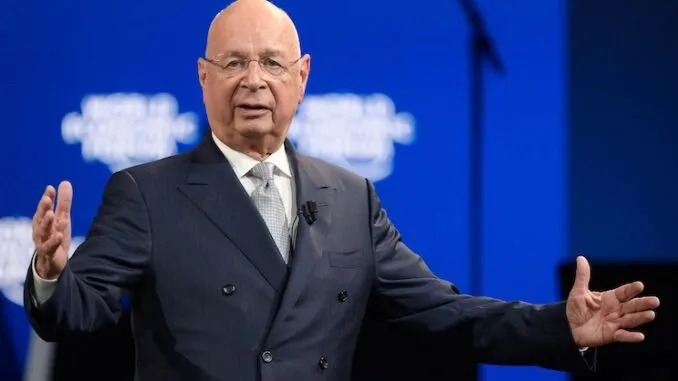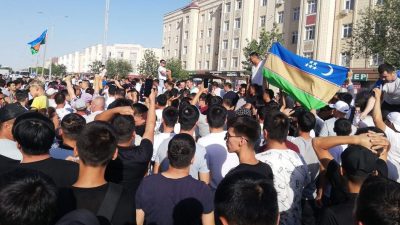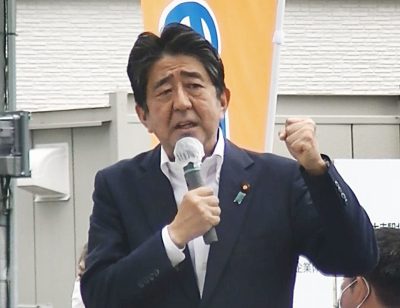When the Globalists Crossed the Rubicon: The Assassination of Shinzo Abe
All Global Research articles can be read in 51 languages by
activating the “Translate Website” drop down menu on the top banner of
our home page (Desktop version).
To receive Global Research’s Daily Newsletter (selected articles), click here.
Follow us on Instagram and Twitter and subscribe to our Telegram Channel. Feel free to repost and share widely Global Research articles.
***
To read this article in Japanese, click the Translate Website drop down menu
この記事を日本語で読むには、ウェブサイトの翻訳ドロップダウンウェブサイトをクリックしてください。
***
July 8 was a muggy day in the ancient capital of Japan. Shinzo Abe,
the most powerful figure in Japanese politics, was delivering a stump
speech for a local Liberal Democratic Party candidate in front of the
Nara Kintetsu railway station when suddenly a loud bang rang out,
followed by an odd cloud of smoke.
The response was incredible. Among those in the unusually large crowd
gathered, not a single person ran for cover, or hit the ground in
terror.
Abe’s body guards, who stood unusually far away from him during the
speech, looked on impassively, making no effort to shield him, or to
pull him to a safe location.
A few seconds later, Abe crumpled and collapsed to the ground, lying
there impassive in his standard blue jacket, white shirt, now speckled
with blood, and trademark blue badge of solidarity with Japanese
abductees in North Korea. Most likely he was killed instantaneously.
Only then did the body guards seize the suspect, Yamagami Toruya,
who was standing behind Abe. The tussle with Yamagami took the form of a
choreographed dance for the television audience, not a professional
takedown.
Yamagami was immediately identified by the media as a 41-year-old
former member of the Maritime Self-Defense Force who had personal
grievances with Abe.
Yamagami told everything to the police without hesitation. He did not
even try to run from the scene and was still holding the silly
hand-made gun when the bodyguards grabbed him.
Even after Abe was lying on the pavement, not a single person in the
crowd ran for shelter, or even looked around to determine where the
shots came from. Everyone seemed to know, magically, that the shooting
was over.
Then the comedy began. Rather than putting Abe in a limousine and
whisking him away, those standing around him merely called out to
passersby, asking if anyone was a doctor.
The media immediately embraced the “lone gunman” conclusion for this
attack, repeating entertaining tale of how Yamagami was associated with
Toitsu Kyokai, a new religion started by the charismatic shaman Kawase
Kayo, and why he blamed Abe, who had exchanges with that group, for his
mother’s troubles.
Because Toitsu Kyokai has followers from the Unification Church
founded by Reverend Moon Sun Myung, journalist Michael Penn jumped to
the conclusion that the conspiracy leading to Abe’s death was the result of his collaboration with the Moonies.
Although the mainstream media accepted this fantastic story, the
Japanese police and security apparatus did not manage to squash
alternative interpretations. Blogger Takashi Kitagawa
posted materials on July 10 that suggested Abe was shot from the front,
not from the back where Yamagami stood, and that the shots must have
been fired at an angle from the top of one, or both, of the tall
buildings on either side of the intersection across from the railway
station plaza.
Takahashi Kitakawa’s postings:
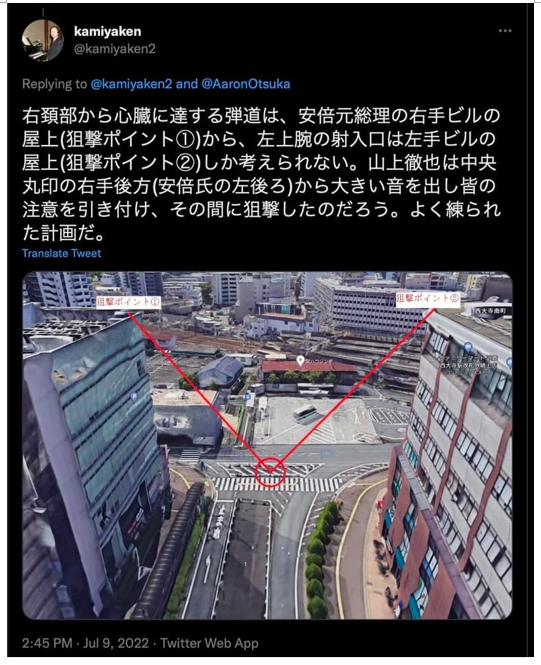
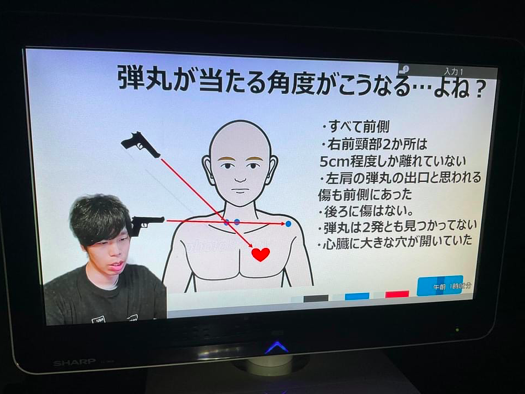
Kitagawa’s analysis of the paths of the bullets was more scientific than anything offered by the media that had claimed, without basis, that Abe had only been shot once until the surgeon announced that evening that there had been two bullets.
The chances that a man holding an awkward home-made gun, standing
more than five meters away in a crowd, would be able to hit Abe twice
are low. The TV personality Kozono Hiromi, who is a gun expert himself,
remarked on his show “Sukkiri” (on July 12) that such a feat would be incredible.
A careful viewing of the videos suggests that multiple shots
were fired by a rifle with a silencer from atop a neighboring building.
安倍晋三元総理大臣暗殺について 言明します from Emanuel Pastreich on Vimeo.
The message to the world
For a figure like Shinzo Abe, the most powerful political player in
Japan and the person to whom Japanese politicians and bureaucrats
rallied in response to the unprecedented uncertainty born of the current
geopolitical crisis, to be shot dead with no serious security detail nearby makes no sense.
Perhaps the message was lost on viewers at home, but it was crystal
clear for other Japanese politicians. For that matter, the message was
clear for Boris Johnson, who was forced out of power at almost exactly the same moment that Abe was shot, or for Emmanuel Macron,
who was suddenly charged with influence peddling scandal for Uber, and
faces demands for his removal from office, on July 11—after months of
massive protests had failed to sway him in any way.
The message was written all over Abe’s white shirt in red: buying
into the globalist system and promoting the COVID-19 regime is not
enough to assure safety, even for the leader of a G7 nation.
Abe was highest ranking victim so far of the hidden cancer eating
away at governance in nation states around the world, an institutional
sickness that moves decision making away from national governments to a
network of privately-held supercomputer banks, private equity groups,
for-hire intelligence firms in Tel Aviv, London and Reston, and the
strategic thinkers employed by the billionaires at the World Economic
Forum, NATO, the World Bank and other such awesome institutions.
The fourth industrial revolution was the excuse employed to transfer
the control of all information in, and all information out, for central
governments to Facebook, Amazon, Oracle, Google, SAP and others in the
name of efficiency. As J. P. Morgan remarked, “Everything has two
reasons: a good reason and a real reason.”
With the assassination of Abe, these technology tyrants, and their
masters, have crossed the Rubicon, declaring that those dressed in the
trappings of state authority can be mowed down with impunity if they do
not follow orders.
The Problem with Japan
Japan is heralded as the only Asian nation advanced enough to join
the “West,” to be a member of the exclusive G7 club, and to be qualified
to enter into collaboration with (and possible membership in) the top
intelligence sharing program, the “Five Eyes.” Nevertheless, Japan has
continued to defy the expectations, and the demands, of global
financiers, and the planners within the beltway and on Wall Street for
the New World Order.
Although it was South Korea in Asia that has constantly been berated
in Washington as an ally not quite up to the level of Japan, the truth
is that the super-rich busy taking over the Pentagon, and the entire
global economy, were starting to harbor doubts about the dependability
of Japan.
The globalist system at the World Bank, Goldman Sachs, or the Belfer
Center for Science and International Affairs at Harvard University has a
set track for the best and the brightest from “advanced nations.”
Elites from Australia, France, Germany, Norway or Italy, learn to
speak fluent English, spend time in Washington, London, or Geneva at a
think tank or university, secure a safe sinecure at a bank, a government
institution, or a research institute that assures them a good income,
and adopt the common sense, pro-finance, perspective offered by the
Economist Magazine as the gospel.
Japan, however, although it has an advanced banking system of its
own, although its command of advanced technologies makes it the sole
rival of Germany in machine tools, and although it has a sophisticated
educational system capable of producing numerous Nobel Prize winners,
does not produce leaders who follow this model for the “developed”
nation.
Japanese elite do not study abroad for the most part and Japan has
sophisticated intellectual circles that do not rely on information
brought in from overseas academic or journalistic sources.
Unlike other nations, Japanese write sophisticated journal articles
entirely in Japanese, citing only Japanese experts. In fact, in fields
like botany and cellular biology, Japan has world-class journals written
entirely in Japanese.
Similarly, Japan has a sophisticated domestic economy that is not
easily penetrated by multinational corporations—try as they do.
The massive concentration of wealth over the last decade has allowed
the super-rich to create invisible networks for secret global
governance, best represented by the World Economic Forum’s Young Global
Leaders program and the Schwarzman Scholars program. These rising
figures in policy infiltrate the governments, the industries, and
research institutions of nations to make sure that the globalist agenda
goes forth unimpeded.
Japan has been impacted by this sly form of global governance. And
yet, Japanese who speak English well, or who study at Harvard, are not
necessarily on the fast track in Japanese society.
There is stubborn independence in Japan’s diplomacy and economics,
something that raised concerns among the Davos crowd during the COVID-19
campaigns.
Although the Abe administration (and the subsequent Kishida
administration) went along with the directives of the World Economic
Forum and the World Health Organization for vaccines and social
distancing, the Japanese government was less intrusive in the lives of
citizens than most nations, and was less successful in forcing
organizations to require vaccination.
The use of QR codes to block service to the unvaccinated was limited
in its implementation in Japan in comparison with other “advanced”
nations.
Moreover, the Japanese government refuses to fully implement the
digitalization agenda demanded, thus denying multinational technology
giants the control over Japan that they exercise elsewhere. This lag in
Japan’s digitalization led the Wilson Center in Washington D.C. to
invite Karen Makishima,
minister of Japan’s Digital Agency (launched under pressure from global
finance in September, 2021) so that she could explain why Japan has
been so slow to digitalize (July 13).
Japanese are increasingly aware that their resistance to
digitalization, to the wholescale outsourcing of the functions of
government and university to multinational tech giants, and the
privatization of information, is not in their interest.
Japan continues to operate Japanese-language institutions that follow
old customs, including the use of written records. Japanese still read
books and they are not so enamored with AI as Koreans and Chinese.
Japan’s resistance can be traced back to Meiji restoration of 1867.
Japan set out to create governmental system wherein Western ideas were
translated into Japanese, combined with Japanese concepts, to create a
complex domestic discourse. The governance system set up in Meiji
restoration remains in place to a large degree, using models for
governance based on pre-modern principles from Japan and China’s past,
and drawn from 19th century Prussia and England.
The result is feudalistic approach to governance wherein ministers
oversee fiefdoms of bureaucrats who carefully guard their own budgets
and who maintain their own internal chains of command.
The Problem with Abe
Shinzo Abe was one of the most sophisticated politicians of our age,
always open to make a deal with the United States, or other global
institutions, but always cagy when it came to making Japan the subject
of globalist dictates.
Abe harbored the dream of restoring Japan to its status as an empire,
and imagined himself to be the reincarnation of the Meiji Emperor.
Abe was different from Johnson or Macron in that he was not as
interested in appearing on TV as he was in controlling the actual
decision making process within Japan.
There is no need to glorify Abe’s reign, as some have tried to do. He
was a corrupt insider who pushed for the dangerous privatization of
government, the hollowing out of education, and who backed a massive
shift of assets from the middle class to the wealthy.
His use of the ultra-right Nihon Kaigi forum to promote an
ultranationalist agenda, and to glorify the most offensive aspects of
Japan’s imperial past, was deeply disturbing. Abe gave his unflinching
support for all military expenditures, no matter how foolish, and he was
willing to support just about any American boondoggle.
That said, as the grandson of Prime Minister Nobusuke Kishi, and the
son of foreign minister Shintaro Abe, Shinzo Abe showed himself to be an
astute politician from childhood. He was creative in his use of a wide
range of political tools to advance his agenda, and he could call on
corporate and government leaders from around the world with an ease that
no other Asian politician could.
I remember vividly the impression I received from Abe on the two
occasions that I met him in person. Whatever cynical politics he may
have promoted, he radiated to his audience a purity and simplicity, what
the Japanese call “sunao,” that was captivating. His manner suggested a
receptiveness and openness that inspired loyalty among his followers
and that could overwhelm those who were hostile to his policies.
In sum, Abe was sophisticated political figure who was capable of
playing one side against the other within the Liberal Democratic Party,
and within the international community, while appearing to be a
considerate and benevolent leader.
For this reason, Japanese hostile to Abe’s ethnic nationalism were
still willing to support him because he was the only politician they
thought capable of restoring global political leadership to Japan.
Japanese diplomats and military officers fret endlessly about the
Japan’s lack of vision. Although Japan has all the qualifications to be a
great power, they reason, it is run by a series of unimpressive,
University of Tokyo graduates; men who are good at taking tests, but are
unwilling to take risks.
Japan produces none like Putin or Xi, and not even a Macron or a Johnson.
Abe wanted to be a leader and he had the connections, the talent, and
the ruthlessness required to play that role on the global stage. He was
already the longest serving prime minister in Japanese history, and had
plans for a third bid as prime minister, when he was struck down.
Needless to say, the powers behind the World Economic Forum do not
want national leaders like Abe, even if they conform with the global
agenda, because they are capable of organizing resistance within the
nation state.
What went wrong?
Abe was able to handle, using the traditional tools of statecraft,
the impossible dilemma faced by Japan over the last decade as its
economic ties with China and Russia increased, but its political and
security integration with the United States, Israel and the NATO block
proceeded apace.
It was impossible for Japan to be that close to the United States and
its allies while maintaining friendly relations with Russia and China.
Yet Abe almost succeeded.
Abe remained focused and cool. He made use of all his skills and
connections as he set out to carve a unique space for Japan. Along the
way, Abe turned to the sophisticated diplomacy of his strategic thinker Shotaro Yachi of the Ministry of Foreign Affairs to assure that Japan found its place under the sun.
Abe and Yachi used contradictory, but effective, geopolitical
strategies to engage both East and West, making ample use of secret
diplomacy to seal long-term deals that put Japan back in the great
powers game.
On the one hand, Abe presented to Obama and Trump a Japan that was
willing to go further than South Korea, Australia or other India in
backing Washington’s position. Abe was willing to suffer tremendous
domestic criticism for his push for a remilitarization that fit the US
plans for East Asia.
At the same time that he impressed Washington politicians with his
gung-ho pro-American rhetoric, matched by the purchase of weapons
systems, Abe also engaged China and Russia at the highest levels. That
was no small feat, and involved sophisticated lobbying within the
beltway, and in Beijing and Moscow.
In the case of Russia, Abe successfully negotiated a complex peace treaty
with Russia in 2019 that would have normalized relations and solved the
dispute concerning the Northern Territories (the Kuril Islands in
Russian). He was able to secure energy contracts for Japanese firms and
to find investment opportunities in Russia even as Washington ramped up
the pressure on Tokyo for sanctions.
The journalist Tanaka Sakai
notes that Abe was not banned from entering Russia after the Russian
government banned all other representatives of the Japanese government
from entry.
Abe also engaged China seriously, solidifying long-term institutional
ties, and pursuing free trade agreement negotiations that reached a
breakthrough in the fifteenth round of talks (April 9-12, 2019). Abe had
ready access to leading Chinese politicians and he was considered by
them to be reliable and predictable, even though his rhetoric was
harshly anti-Chinese.
The critical event that likely triggered the process leading to Abe’s assassination was the NATO summit in Madrid (June 28-30).
The NATO summit was a moment when the hidden players behind the
scenes laid down the law for the new global order. NATO is on a fast
track to evolve beyond an alliance to defend Europe and to become an
unaccountable military power, working with the Global Economic Forum,
the billionaires and the bankers around the world, as a “world army,”
functioning much as the British East India Company did in another era.
The decision to invite to the NATO summit the leaders of Japan, South
Korea, Australia and New Zealand was a critical part of this NATO
transformation.
These four nations were invited to join in an unprecedented level of
integration in security, including intelligence sharing (outsourcing to
big tech multinationals), the use of advanced weapons systems (that must
be administrated by the personnel of multinationals like Lockheed
Martin), joint exercises (that set a precedent for an oppressive
decision-making process), and other “collaborative” approaches that
undermine the chain of command within the nation state.
When Kishida returned to Tokyo on July first, there can be no doubt
that one of his first meetings was with Abe. Kishida explained to Abe
the impossible conditions that the Biden administration had demanded of
Japan.
The White House, by the way, is now entirely the tool of globalists
like Victoria Nuland (Under Secretary of State for Political Affairs)
and others trained by the Bush clan.
The demands made of Japan were suicidal in nature. Japan was to
increase economic sanctions on Russia, to prepare for possible war with
Russia, and to prepare for a war with China. Japan’s military,
intelligence and diplomatic functions were to be transferred to the
emerging blob of private contractors gathering for the feast around
NATO.
We do not know what Abe did during the week before his death. Most
likely he launched into a sophisticated political play, using of all his
assets in Washington D.C., Beijing, and Moscow—as well as in Jerusalem,
Berlin, and London, to come up with a multi-tiered response that would
give the world the impression that Japan was behind Biden all the way,
while Japan sought out a détente with China and Russia through the back
door.
The problem with this response was that since other nations had been
shut down, such a sophisticated play by Japan made it the only major
nation with a semi-functional executive branch.
Abe’s death parallels closely that of Seoul’s mayor Park Won Sun, who went missing on July 9th,
2020, exactly two years before Abe’s assassination. Park took steps in
Seoul City Hall to push back on the COVID-19 social distancing policies
that were being imposed by the central government. His body was found
the next day and the death was immediately ruled a suicide resulting
from his distress over charges of sexual harassment by a colleague.
What to do now?
The danger of the current situation should not be underestimated. If
an increasing number of Japanese come to perceive, as the journalist
Tanaka Sakai suggests, that the United States destroyed their best hope
for leadership, and that the globalists want Japan to make do with an
unending series of weak-minded prime ministers who are dependent on
Washington and other hidden players of the parasite class, such a
development could bring about a complete break between Japan and the
United States, leading to a political or military conflict.
It is telling that Michael Green, the top Japan hand in Washington
D.C., did not write the initial tribute to Abe that was published on the
homepage of CSIS (Center for Strategic and International Studies), his
home institute.
Green, veteran of the Bush National Security Council and Henry A. Kissinger Chair of the Asia Program at CSIS, is the author of Line
of Advantage: Japan’s Grand Strategy in the Era of Abe Shinzo. Green
was a close associate of Abe, perhaps the closest of any American.
The tribute to Abe was drafted by Christopher Johnstone (the Japan
chair at CSIS and former CIA officer). The weird choice suggests that
the assassination is so sensitive that Green instinctively wished to
avoid writing the initial response, leaving it to a professional
operative.
For responsible intellectuals and citizens in Washington, Tokyo, or
elsewhere, there is only one viable response to this murky
assassination: a demand for an international scientific investigation.
Painful as that process might be, it will force us to face the
reality of how our governments have been taken over by invisible powers.
If we fail to identify the true players behind the scenes, however,
we may be led into a conflict in which the blame is projected onto heads
of state and countries are forced into conflicts so as to hide the
crimes of global finance.
The loss of control of the Japanese government over the military the
last time can be attributed in part to the assassinations of prime
minister Inukai Tsuyoshi on May 15, 1932 and of prime minister Saito
Makoto on February 26, 1936.
But for the international community, the more relevant case is how
the manipulations of an integrated global economy by the Rothschild,
Warburg, and other banking interests created an environment wherein the
tensions produced by the assassination of Archduke Franz Ferdinand of
Austria-Hungary on June 28, 1914 were funneled towards world war.
*
Note to readers: Please click the share buttons above or below.
Follow us on Instagram and Twitter and subscribe to our Telegram
Channel. Feel free to repost and share widely Global Research articles.
Emanuel Pastreich served as the president of the
Asia Institute, a think tank with offices in Washington DC, Seoul,
Tokyo and Hanoi. Pastreich also serves as director general of the
Institute for Future Urban Environments. Pastreich declared his
candidacy for president of the United States as an independent in
February, 2020.






